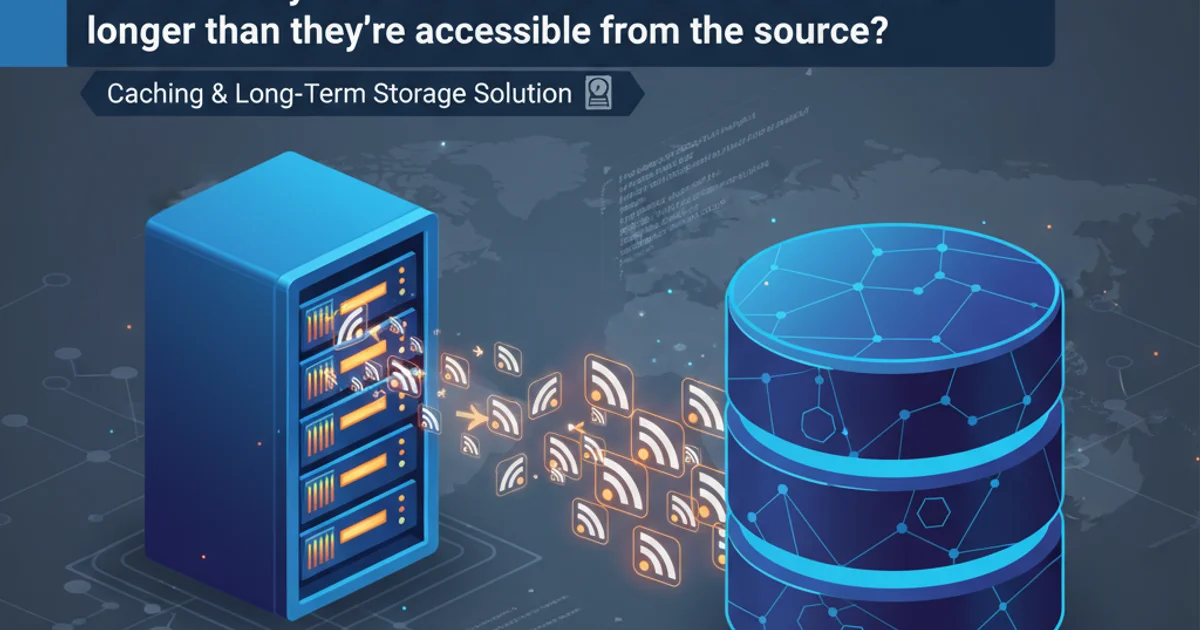How would you make an RSS-feeds entries available longer than they're accessible from the source?
Categories:
Archiving RSS Feeds: Ensuring Long-Term Content Availability

Learn how to cache and store RSS feed entries beyond their source availability, enabling offline access and historical data retention for podcasts, news, and more.
RSS (Really Simple Syndication) feeds are a cornerstone of content distribution, providing timely updates from websites, blogs, and podcasts. However, the nature of RSS feeds means that older entries often get pruned or become inaccessible from the source after a certain period. This presents a challenge for users who wish to retain content longer, access it offline, or build historical archives. This article explores various strategies and technical approaches to make RSS feed entries available longer than their original source retention policy, focusing on caching, storage, and retrieval mechanisms.
Understanding the Need for Extended Retention
The primary reason for extending RSS feed retention is often content preservation. For podcasts, this might mean keeping episodes available even if the host removes them. For news feeds, it could be about maintaining a personal archive of articles. Developers might need historical data for analysis, machine learning, or building custom applications that rely on past content. Without a dedicated caching or archiving solution, this content is lost once the source feed updates or removes it.
flowchart TD
A[RSS Source Feed] --> B{Fetch Interval}
B --> C[RSS Fetcher Service]
C --> D{New Entries?}
D -- Yes --> E[Content Parser]
E --> F[Data Storage (Database/Filesystem)]
F --> G[Archived Content]
D -- No --> C
G --> H[User/Application Access]Basic workflow for archiving RSS feed entries.
Core Components of an RSS Archiving System
Building a robust RSS archiving system involves several key components working in concert. At its heart is a mechanism to regularly fetch the RSS feed, parse its contents, and store new entries. This system needs to be resilient, handle potential network issues, and efficiently manage storage. Consider the following architectural elements:
1. RSS Fetcher
A scheduled task or service that periodically retrieves the RSS feed XML from its source URL. This component should handle HTTP requests, retries, and potentially ETag/Last-Modified headers for efficient fetching.
2. Content Parser
Once the XML is fetched, this component parses the feed to extract individual entries (items). It should identify unique identifiers for each entry (e.g., <guid>, <link>) to prevent duplicates and extract relevant data like title, description, publication date, and media enclosures (for podcasts).
3. Data Storage
A persistent storage solution to save the parsed entries. This could be a relational database (e.g., PostgreSQL, MySQL), a NoSQL database (e.g., MongoDB, SQLite for simpler setups), or even a file system for storing raw XML or serialized data. The choice depends on scalability, query needs, and complexity.
4. Media Downloader (Optional but Recommended for Podcasts)
For feeds containing media enclosures (like podcast audio files), a separate component to download and store these files locally. This ensures true offline availability and prevents reliance on the original media host.
5. Access Layer
A way to access the archived content. This could be a simple web interface, an API, or a custom application that reads directly from the storage. For podcasts, this might involve generating a new RSS feed URL pointing to your archived media.
Implementation Strategies and Technologies
The choice of technology depends on your technical expertise, desired scale, and specific requirements. Here are a few common approaches:
guid or link), the feed's URL, and the timestamp of when you first processed the item. This is crucial for deduplication and historical tracking.1. Script-Based Archiving (Python Example)
For personal use or smaller-scale archiving, a simple Python script can be highly effective. It can be scheduled to run periodically using cron (Linux/macOS) or Task Scheduler (Windows).
import feedparser
import sqlite3
import os
FEED_URL = 'https://example.com/rss-feed.xml'
DATABASE_FILE = 'rss_archive.db'
def init_db():
conn = sqlite3.connect(DATABASE_FILE)
cursor = conn.cursor()
cursor.execute('''
CREATE TABLE IF NOT EXISTS entries (
guid TEXT PRIMARY KEY,
title TEXT,
link TEXT,
published TEXT,
summary TEXT,
feed_url TEXT
)
''')
conn.commit()
conn.close()
def fetch_and_store_feed(feed_url):
feed = feedparser.parse(feed_url)
conn = sqlite3.connect(DATABASE_FILE)
cursor = conn.cursor()
for entry in feed.entries:
guid = entry.get('guid', entry.link) # Use link as fallback for guid
try:
cursor.execute(
"INSERT INTO entries (guid, title, link, published, summary, feed_url) VALUES (?, ?, ?, ?, ?, ?)",
(guid, entry.title, entry.link, entry.published, entry.summary, feed_url)
)
print(f"Added: {entry.title}")
except sqlite3.IntegrityError:
print(f"Skipped (already exists): {entry.title}")
conn.commit()
conn.close()
if __name__ == '__main__':
init_db()
fetch_and_store_feed(FEED_URL)
print("Archiving complete.")
Python script to fetch an RSS feed and store entries in an SQLite database.
2. Using Dedicated RSS Reader/Aggregator Software
Many modern RSS readers and aggregators offer built-in caching mechanisms. While they might not explicitly advertise 'infinite' retention, many will keep entries for a significant period or until you manually delete them. Some self-hosted options provide more control over the underlying database and storage.
3. Cloud-Based Solutions and Serverless Functions
For more scalable or hands-off solutions, cloud platforms offer powerful tools. You can use serverless functions (e.g., AWS Lambda, Google Cloud Functions) triggered by a schedule to fetch feeds, parse them, and store data in cloud databases (e.g., DynamoDB, Firestore) or object storage (e.g., S3 for media files).
sequenceDiagram
participant User
participant Scheduler
participant Lambda/CloudFunction
participant RSSSource
participant Database
participant ObjectStorage
User->>Scheduler: Configure fetch interval
Scheduler->>Lambda/CloudFunction: Trigger (e.g., every hour)
Lambda/CloudFunction->>RSSSource: Fetch RSS Feed XML
RSSSource-->>Lambda/CloudFunction: RSS XML Data
Lambda/CloudFunction->>Lambda/CloudFunction: Parse XML, Extract Entries
Lambda/CloudFunction->>Database: Store new entry metadata
alt If media enclosure exists
Lambda/CloudFunction->>RSSSource: Download media file
RSSSource-->>Lambda/CloudFunction: Media File Data
Lambda/CloudFunction->>ObjectStorage: Store media file
end
Lambda/CloudFunction-->>Scheduler: Acknowledge completion
User->>Database: Access archived content
User->>ObjectStorage: Access archived mediaSequence diagram for a cloud-based RSS archiving system using serverless functions.
Considerations for Media Files (Podcasts)
When archiving podcasts, simply storing the RSS entry metadata isn't enough. The actual audio files are often hosted externally and can be removed. To ensure long-term availability, you must download and store these media files yourself. This requires significant storage capacity and bandwidth.